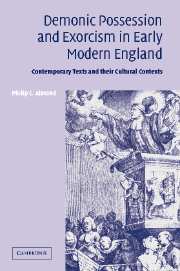 Demonic Possession and Exorcism in Early Modern England
Demonic Possession and Exorcism in Early Modern England Published online by Cambridge University Press: 22 September 2009
In the early evening of Thursday 16 December 1602, Satan departed from fourteen-year-old Mary Glover, the daughter of the staunchly Puritan Timothy Glover, merchant of Thames Street in London. Life returned to her body, and lifting her hands up high, she cried out ‘He is come, he is come’, and then, ‘The comforter is come. O Lord, you have delivered me.’ These were the words of her Grandfather, Robert Glover, we are informed, as he was going to be executed by burning.
Mary Glover was the granddaughter of Robert Glover, burned at Lichfield during the reign of Mary on 20 September 1555. For the Puritan John Swan, Mary, like her grandfather, is the victim of persecution both demonic and official. Swan's anger, like that of John Darrell and George More, is directed against Samuel Harsnett in his capacity as Chaplain to Richard Bancroft the Bishop of London, and discrediter of exorcists, both Catholic and Protestant. Harsnett had referred to Swan, along with three other Puritan ministers involved in the dispossession of Mary, as ‘devil-finders and devil-puffers, or devil-prayers’ in his A Declaration of Egregious Popish Impostures. It was both this defamation and Harsnett’s belief that ‘the opinions of witches [to] be brainless imaginations’ that motivated Swan to give us his very detailed account of a Puritan exorcism.
In prefacing his work with a letter to King James I, Swan was no doubt optimistic that he would receive a sympathetic hearing.
To save this book to your Kindle, first ensure no-reply@cambridge.org is added to your Approved Personal Document E-mail List under your Personal Document Settings on the Manage Your Content and Devices page of your Amazon account. Then enter the ‘name’ part of your Kindle email address below. Find out more about saving to your Kindle.
Note you can select to save to either the @free.kindle.com or @kindle.com variations. ‘@free.kindle.com’ emails are free but can only be saved to your device when it is connected to wi-fi. ‘@kindle.com’ emails can be delivered even when you are not connected to wi-fi, but note that service fees apply.
Find out more about the Kindle Personal Document Service.
To save content items to your account, please confirm that you agree to abide by our usage policies. If this is the first time you use this feature, you will be asked to authorise Cambridge Core to connect with your account. Find out more about saving content to Dropbox.
To save content items to your account, please confirm that you agree to abide by our usage policies. If this is the first time you use this feature, you will be asked to authorise Cambridge Core to connect with your account. Find out more about saving content to Google Drive.